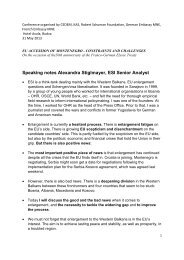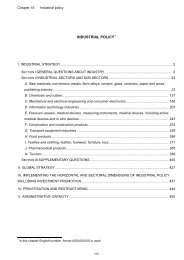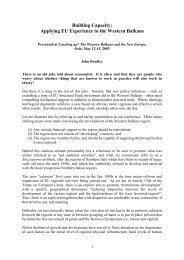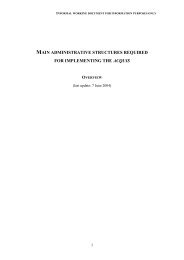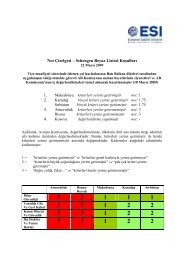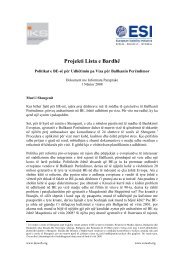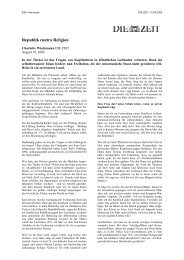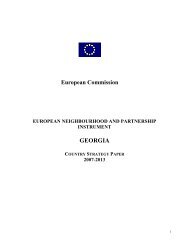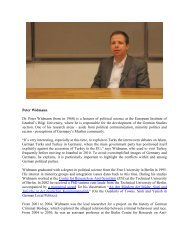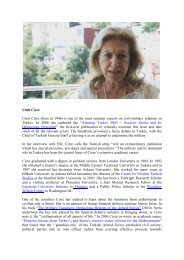MURDER IN ANATOLIA - European Stability Initiative - ESI
MURDER IN ANATOLIA - European Stability Initiative - ESI
MURDER IN ANATOLIA - European Stability Initiative - ESI
You also want an ePaper? Increase the reach of your titles
YUMPU automatically turns print PDFs into web optimized ePapers that Google loves.
– 32 –<br />
difficult situation and to weaken it. The plans indicated that missionary activities were<br />
increasing in Malatya and that there would be some operations.” 221<br />
Muzaffer Tekin, a retired captain and member of the ultranationalist Worker‟s Party, played a<br />
leading role in organizing protests against Christians and liberal writers in Istanbul in 2006<br />
and 2007 together with former gendarmerie general Veli Kucuk and other ultranationalists.<br />
He was linked to handgrenades found in Istanbul in 2007 in a place owned by a close<br />
associate of his, another retired military called Oktay Yilidirm. Tekin was charged with<br />
having ordered the 2006 attack killing a judge in Ankara (see page 4). Tekin was indicted in<br />
the first Ergenekon indictment in 2008.<br />
Ozen claimed to know high-ranking figures in the military hierarchy. “When I was in 1997 in<br />
Balikesir-Edremit as an infantry soldier, my commander was Hakan Korkmaz. We would go<br />
out together. On one of these occasions we met Muzaffer Tekin. Until the end of 2005 I met<br />
Muzaffer Tekin many times.” 222 It was during one of these meetings that he learned about<br />
concrete assassination plans, Ozen testified.<br />
“I know that from 2004 onwards, the Hrant Dink and Malatya operations were brought to<br />
an active status. There was talk that there were missionary activities in Malatya and<br />
surrounding areas. I also heard that efforts were made to discredit the government in<br />
power. I met with Veli Kucuk, Levent Ersoz and Muzaffer Tekin at the end of 2004 in<br />
the Istanbul Sariyer officers‟ club together with persons with the code names Siran and<br />
Yusuf. I was outside the room. According to what Siran and Yusuf told me, there would<br />
be an operation against missionaries in Malatya to discredit the government. The efforts<br />
were brought to active status and although no date had yet been set for the operations,<br />
preparations began.” 223<br />
This was a few months before the Malatya Ulku Ocaklari organised demonstrations against<br />
local Christians.<br />
Answering a question about JITEM activities, Ozen explained:<br />
“The system worked in cell structures of 3, 4 or 6 persons. The higher ranks (ustler) gave<br />
the order for an operation. The planning was done by Levent Ersoz, Muzaffer Tekin and<br />
Veli Kucuk. During the implementation, people from different segments were used. The<br />
commanders decided that.” 224<br />
Ozen also claimed that the rector of Malatya‟s Inonu University, Fatih Hilmioglu, supported<br />
these activities and the monitoring of missionaries in Malatya by his staff.<br />
Hilmioglu had already been arrested in April 2009 and indicted in connection with the<br />
Ergenekon court case. He was a close associate of the former head of the gendarmerie in<br />
Turkey, Sener Eruygur, who stands trial for plotting to overthrow the government in 2003-<br />
221 Today’s Zaman, “Witness in Malatya murders case says he worked for JITEM”, 13 October 2010,<br />
http://www.todayszaman.com/tz-web/news-224254-witness-in-malatya-murders-case-says-he-worked-for-<br />
JITEM.html.<br />
222 Protocol of the 29 th Court Hearing, 15 October 2010, p. 3.<br />
223 Protocol of the 29 th Court Hearing, 15 October 2010, p. 4.<br />
224 Protocol of the 29 th Court Hearing, 15 October 2010, p. 4.<br />
~ www.esiweb.org ~





